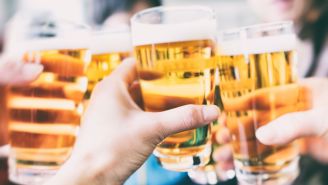Alcoholics Anonymous is the most effective path to achieving sobriety, according to a March 2020 review of studies published in the Cochrane Database of Systematic Review. Scientists analyzed data from more than 10,000 people and found that A.A. worked just as well or better than other alcohol use interventions—and often lowered healthcare costs, as well. Researcher Keith Humphreys, PhD, theorized that the program’s success was likely due to its emphasis on emotional support and practical tips from people who have been in the same situation.
Recent trends indicate more Americans than ever may need that help, too. A 2020 study in the journal Alcoholism: Clinical and Experimental Research found that the rate of alcohol-related deaths rose by more than 50 percent between 1999 and 2017. The increase was larger for women, though men continue to die more frequently of alcohol-related causes.
Learn how alcohol affects your health, both immediately and over the long term—plus steps you can take to cut back on drinking.
Heavy drinking and your health
The Centers for Disease Control and Prevention (CDC) defines heavy drinking as more than 8 alcoholic beverages per week for women and more than 15 per week for men. Binge drinking, meanwhile, is defined as 4 or more drinks per occasion for women and 5 or more for men. About one in six United States adults binge drinks around four times a month, averaging out to a staggering 529 alcoholic drinks yearly.
Excessive alcohol consumption can have many negative short-term health effects, such as unintentional injuries or alcohol poisoning. It can inhibit decision-making, which may lead to risky sexual behaviors, acts of violence or motor vehicle accidents. That’s not all; just one night of heavy drinking can mess with your mood, gastrointestinal function and sleep patterns for days to come.
Binge drinking can also have numerous long-term consequences. The risk of breast, mouth, throat, esophagus, liver and colon cancer rises with higher alcohol use. People who binge drink have a greater chance of developing liver or heart disease. Mental health disorders are often exacerbated with alcohol use. And even though 90 percent of binge drinkers are not alcohol dependent, binging does increase the likelihood of developing alcohol use disorder.
Excessive drinking has also been found to cause impotence and infertility in men. In women, binge drinking may increase the risk of infertility by disrupting the menstrual cycle. If you are pregnant, no amount of alcohol is safe; it puts the developing fetus at risk of fetal alcohol syndrome.
How to cut back on alcohol
If you find yourself consistently drinking more than you should, you can take these steps to help cut back on drinking or quit imbibing altogether.
Pay attention to serving size. The CDC defines one drink as 12 ounces of beer (5 percent ABV), 8 ounces of malt liquor, 5 ounces of wine or a 1 1/2-ounce shot. Moderate alcohol consumption is considered to be one drink per day for women and up to two per day for men.
Most restaurants and bars serve well over what is considered to be a standard-sized drink. When you’re eating out, order beer in a can or bottle to keep it close to 12 ounces or ask for a light pour of wine. If you can’t control the amount you’re receiving per glass, plan to drink less than you had anticipated.
It’s also easy to pour too much alcohol at home. Try measuring your drinks and keeping track of how many you’ve had. One good way to start cutting back on drinking is to track your beverages by logging them in an app like Sharecare, available for iOS or Android, or by taking notes in your smartphone.
Break up your drinking. If you have more than one drink in a sitting, alternate them with nonalcoholic beverages such as water, seltzer, juice or soda. When you’re drinking, keep a glass of water nearby to stay hydrated. Try limiting your drinks to mealtimes, too, since a full stomach will help you absorb the alcohol more slowly.
Socialize without alcohol. If you find yourself using drinking as your main form of social interaction or as part of a hobby, it might be time for a change. Instead of going to the bar, make plans with friends that don’t involve alcohol. Try a cooking or art lesson, or perhaps a new exercise class with a friend.
The National Institute on Alcohol Abuse and Alcoholism suggests implementing small changes to start. But if you’ve tried and still aren’t able to cut back on drinking after three months, you should consider quitting altogether. If you need help, talk with your healthcare provider to devise a plan that works best for you.







